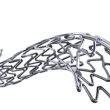Secondary prevention with P2Y12 inhibitors vs aspirin monotherapy in CAD patients Antiaggregation therapy plays a central role at long term to prevent new cardiovascular events in atherosclerosis patients. After repeat myocardial infarction (MI) or stroke, prognosis can vary considerably. Even though the current guidelines prefer aspirin as the first choice for secondary prevention over P2Y12...
Diffuse Coronary Artery Disease: One-Year 48mm XIENCE Skypoint Outcomes
Long 48mm Stent XIENCE Skypoint in the treatment of diffuse CAD Long coronary artery lesions often involve complex decision making since they can be treated either with a long stent or with shorter overlapping stents. Both in registries and meta-analysis, the overlapping technique has been associated to increased target vessel revascularization and increased radioscopy time,...
Abbreviated Therapy in Patients with Acute Coronary Syndrome: How Safe Is Conservative DAPT Treatment?
Abbreviated dual antiplatelet therapy in patients at high risk for bleeding and acute myocardial infarction. Patients with acute coronary syndrome (ACS) who undergo stent placement (percutaneous coronary intervention, PCI) conventionally require at least 12 months of dual antiplatelet therapy (DAPT) to reduce ischemic events. Patients with ACS who are also at high risk for bleeding...
Abbreviated Antiaggregant Treatment in High Bleeding Risk Patients from the MASTER-DAPT (15-Month Followup)
Benefits of abbreviated antiaggregant treatment in high bleeding risk patients. Dual antiplatelet therapy (DAPT), established by different guidelines, reduces the risk of ischemic events at the expense of increased bleeding. This habitual APT strategy cannot be applied to patients at high risk of bleeding, which is why this populations are treated with shorter DAPT schemes...
Clinical Impact of Coronary Artery Disease on Results After TAVR
Coronary artery disease (CAD) coexists with aortic stenosis in about half the patients who suffer the latter. These patients receiving antiplatelet therapy are at a higher risk of periprocedural bleeding—one of the most frequent complications in patients who undergo transcatheter aortic valve replacement (TAVR). One way of limiting the risk for bleeding is choosing the...
The most read scientific articles in interventional cardiology in February on our website
Below, we share February’s most read scientific abstracts in interventional cardiology at solaci.org. Can Drug Coated Balloon Be a Valid Option for Small Vessels? One of the challenges of percutaneous coronary interventions (PCI) are <2.5 mm vessels, since complications and restenosis complications rate are higher than with >3.0 mm vessels. Is Using Drug-Eluting Balloons and...
Relationship Between Medical Treatment and Long-Term Clinical Results after Peripheral Vascular Intervention
Peripheral arterial disease (PAD) is one of the consequences of atherosclerosis, and it can cause pain in the limbs or tissue loss. Its treatment includes lifestyle changes such as exercise, statin therapy, antiplatelet therapy, antihypertensive medication (mainly ACE inhibitors or ARBs), and revascularization strategy. One in five patients with PAD will have experienced acute myocardial...
Rivaroxaban in Acute Coronary Syndrome
Acute coronary syndromes (ACS) involve high mortality risk, especially ST elevation ACS. Their treatment is based on reperfusion, dual antiplatelet therapy (DAPT) and anticoagulation, with enoxaparin (1 mg/kg twice a day) as the preferred anticoagulant according to the contemporary guidelines. 2.5 mg or 5 mg doses of rivaroxaban might be valid alternative treatments for this...
Plaque Erosion with No Stenting in Acute Coronary Syndrome: Are There Event Predictors to Avoid This Strategy?
Event predictors in patients with plaque erosion and no stenting. A third of all acute coronary syndrome (ACS) cases are caused by plaque erosion. In the initial EROSION study, it was shown that patients with plaque erosion (as evidenced by OCT, with stenosis <70%, TIMI III flow, and asymptomatic) were stabilized without stent implantation (no...
Monotherapy with P2Y12 in Complex Interventions: Less and Less Risky
Monotherapy in patients with complex angioplasty: meta-analysis of 5 randomized studies. Even though prolonged dual antiplatelet therapy (DAPT) might reduce the risk of important ischemic complications, this reduction will come at the expense of a significant increase of bleeding risk, which makes us reassess the cost benefit ratio of this decision. This is also why...








